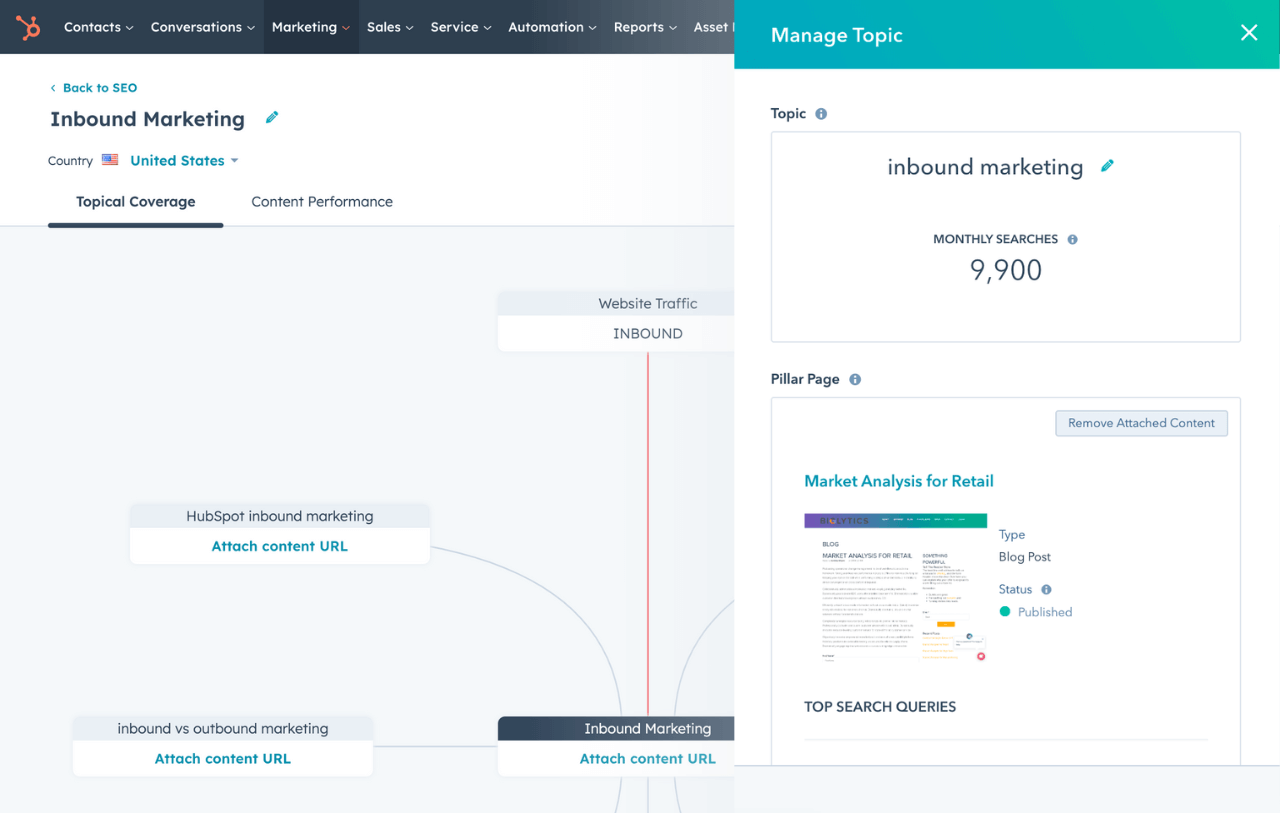I’m a big fan of reporting, and I’ve learned to strike a balance. My SEO report is relatively light work (compared to doing it all manually), but it provides enough of my involvement that I can analyze data as I go and dig into anomalies and justify results, good and bad.
A lot of my reporting is still automated. It’s simple, to the point, and helpful. My clients love it and so do I.
In this article, I break down SEO reporting step-by-step, including what it is, its benefits, and how to create a report that showcases your work, enabling you to make data-driven decisions. There’s also a template to help guide your own report.
Table of Contents
- What is an SEO report?
- What are the benefits of an SEO report?
- How to Create an SEO Report
- SEO Report Template
- SEO Report Best Practices
What is an SEO report?
An SEO report is a document that summarizes your SEO work over a specified period (typically a month). It normally includes work completed, updates on key metrics, highlights of what’s working, and next steps. Its purpose is to clearly communicate results to stakeholders while creating space for SEO teams to process their work’s success and formulate a plan for continuous SEO improvement.
Search engine optimization (SEO) aims to expand a company’s visibility in organic search results. As a result, these efforts drive more visitors to the company’s website, increasing their chances of conversion and leading to increased revenue.
What’s included in an SEO report?
In my experience, you should always tailor your SEO reports to a company’s specific business and marketing goals.
But at a minimum, my SEO reports include:
- Front cover including the client’s brand name, URL, an image, and a report title. My report is titled “Monthly Update Dashboard.”
- An overview, which includes high-level insights, good news, and transparency around key metrics such as clicks, impressions, visibility in AI search, and keywords.
- Technical updates, which usually include small tasks to maintain site health, but in circumstances where a client has serious problems, like indexation, this report can be detailed.
- Page performance, which details the top-performing pages overall. In this report, I like to include all channels from Google Analytics (GA4) so I’m reviewing the site overall, not just the organic.
- AI performance, which includes sessions generated from AI sources. This section of my report is heavily inspired by Kyle Rushton-McGregor’s AI report in GA4.
- Google Search Console (GSC) metrics, including clicks, impressions, click-through-rate, position, top keywords, and a list of all queries ranking.
- Rank tracking, which shows how many keywords are in positions 1-3, 4-10. I sometimes do it with Semrush and input the numbers manually, but some reports use GSC and Looker Studio, so it’s automated.
- Conversions across the site overall, and those that came from organic search.
- Additional works completed detail any tasks that we’ve done that aren’t part of the normal agreement, or are extra for the month.
- Objectives cover the goals for the month ahead based on the findings of the report.
You might also include:
- Backlink profile and analytics showing backlink increases. Ideal if you’re building links or monitoring PR success.
- Local SEO metrics such as calls, directions, and local pack rankings.
- Content performance of specific pages.
- Site speed & Core Web Vitals show a quick check on performance metrics like loading speed, interactivity, and visual stability.
What are the benefits of an SEO report?

There are many benefits to SEO reporting, and I’ve listed five below. Some of them might surprise you.
1. Track and analyze progress against goals.
Once you’ve done your SEO work, you need to know if it’s moving a business in the right direction. This nearly always means generating revenue, but you may also have other goals that lead to revenue, such as specific page views, downloads, or visitors filling out contact forms.
While SEO reports gather metrics, you must examine the data critically. My co-founder, Leigh Buttrey, says you need to “look for the story behind the data.” And I love this approach.
When Leigh and I create a report, we track conversions. From my SEO report, I can see that my client has had an increase in form submissions:

But what about quality?
It’s not enough to look at clicks, or even conversions, without following the trail to sales and finding out what it means for the business.
Here’s an example of what it means to find the story behind the data.
A few months ago, I was given a list of target keywords by a marketing director and a focus for the business. We got to work and everything was going well in terms of rankings, clicks, and conversions.
There was only one problem: The marketing director wasn’t helping us close the loop on what was happening with the leads we were generating.
About a year later, a new marketing director joined the team and changed the focus.
From her perspective, and the way she was changing the business, our original focus wasn’t helping the company as much as other opportunities could. She worked with us and used our reporting data to cross-reference the types of enquiries we were getting and their value. While they were good, she felt a pivot to the strategy would result in more leads.
Without the report and, importantly, her effort in vetting the quality of the leads, we would never have gotten the complete picture.
Our SEO work is now working with a new focus, and leads are of higher value to the company.
2. Demonstrate ROI and gain stakeholder buy-in on organic channels.
When you’re closing the loop on conversions and finding out if the leads you’re generating are of high quality, and actually closing and making money for the business, you can prove your channel’s value.
This matters hugely.
And it helps to prove value through the year.
If you don’t, you might find that when budgets are being set, your work isn’t valued enough to keep getting the budget it needs to be successful. Good reporting is about showcasing value to stakeholders.
I see a common narrative in the SEO world that PPC gets more budget, but PPC teams wouldn’t dream of presenting their work without proving return on investment (ROI).
Not reporting on SEO and ROI won’t fly in a new era of SEO. Now that we have tools like zero-click search, we can’t rely solely on click metrics; we need to consider revenue.
In my reports, I like to track the contact form and the page URL. For most of my clients, we place contact forms on specific pages, such as landing pages or service pages, in the hero section. When someone fills out a form, I want to know where on the site it came from.
Why?
This shows directly where the conversion was made. This data is useful for proving which areas of SEO are working, which are driving conversions (and potentially revenue). Where possible, I follow up on specific leads so I can share which of my efforts have generated actual sales.
It’s not always easy to analyze sales progress, and you need a good team that will keep you informed and close the loop for you. Recently, my client received a $10K lead from ChatGPT. This was because of the great SEO on their site.
Because I track leads, I knew the:
- Budget.
- Source (ChatGPT).
- Client’s name and email.
- Nature of the enquiry.
With this information, I’m able to ask sales what happened. When you have this information, you’ll have the ability to make data-driven decisions to enhance engagement and drive more conversions.
3. Keep teams accountable.
Each month, I like to share my reports with the client. I have a rule that I’m not just going to read off the data; instead, we make a point to discuss elements and make action plans.
When you come back to your report each month, there’s a reasonable challenge for everyone. For example, if SEO requested a landing page, and developers couldn’t get to it, you can ask why, then create a plan to prevent it from happening again.
4. Spot issues early.
When you monitor your site monthly, you identify anomalies that indicate potential issues before they become too severe. For example, I had a client with a canonical issue on their site.
One day, the number of indexed pages for one of my clients had increased dramatically. There were tens of thousands of pages in Google’s index, and we did not want that. They were all parameter pages and offered no value to search.
What had happened was that developers had tried to fix an issue with pagination, but instead, caused a pretty serious problem. If the SEO team wasn’t monitoring indexed pages, we would’ve missed it entirely.
The sudden spike in indexed pages made us dig into the data to see what had happened. We instructed developers to reverse their solution and provided them with an SEO-friendly one, and the whole ordeal was over in a week.
5. Make data-driven decisions about next steps and forecasting.
Data-driven decisions make everything so much better in SEO.
Firstly, you’ll feel better about your recommendations because you can point to why you’re suggesting what you are.
Secondly, stakeholders are more likely to approve your recommendations and release the budget if they can see the potential benefits.
Also, when you report each month, you gain a deeper understanding of your site and audience behavior. You’ll spot when certain pieces of content take off so you can be proactive and edit them ahead of time.
For example, for my client who does Christmas catering, the spike in search is counterintuitively high in June and July. Until I looked at the data, I wouldn’t have expected it to be so far away from December.
How to Create an SEO Report
Here are seven essential steps I follow when creating a report.
Step 1: Decide on your reporting frequency.
If your marketing team already has an SEO reporting cadence, this step has been done for you. However, if you’re at a new business or site, you’ll want to decide how frequently to run these reports.
Are you going to dive in every month, bi-monthly, or every quarter?
To help decide this, think about how often you want to review and analyze data. For me, I like a monthly cadence with ad-hoc check-ins when it feels right. Ask your clients or stakeholders. If they like a report every other month or each quarter, you don’t need to send them a report monthly.
Step 2: Pick your most important KPIs and goals.
Identify the metrics that are most important to your business. At minimum, you’ll likely want:
- Impressions to gauge how much visibility you’re getting. Impressions are the prerequisite to clicks, though impressions can be high and clicks still low with zero-click search, thanks to AI overviews taking some of our clicks.
- Clicks still matter because you don’t make revenue before you get clicked.
- Position of key pages, and the site overall.
- Click-through rate helps you see your best-performing pages.
- AI sessions to get an idea of how many clicks your site is getting from AI search.
- Conversions or key events such as forms filled, downloads, and phone calls.
- Revenue from organic traffic.
You may also want basic data, such as website traffic, page load speed, and backlinks. Additionally, feature other metrics your team already uses to evaluate SEO success.
Determine which keywords you’ve targeted with inorganic and organic campaigns. If you’ve made a push around a certain phrase during the last reporting period, feature it in your report.
Step 3: Choose your layout.
Your SEO report will be something that you and your team review frequently, so you want to ensure the data is presented in a logical and organized manner. If your team has a standard layout, there’s no need to reinvent the wheel.
Starting from scratch? You’ll need to decide how your SEO report will be presented.
Decide if you prefer a:
- Slide template.
- Written report/PDF.
- Looker Studio Dashboard.
- Consider which data visualizations you’ll use.
Lastly, be sure to feature your brand logo and colors so your report feels customized.
Step 4: Decide what can be automated.
To save time and streamline the SEO reporting process, use as much automation as possible without compromising your ability to analyze and process data.
I use Looker Studio with key tools, like GSC and GA4, to automate:
- Traffic numbers by channel.
- Total conversions with month-on-month comparison.
- Clicks, impressions, CTR, and average position, with month-on-month comparison.
- AI performance.
- Specific social media channel (e.g., Facebook or Instagram) performance.
- Top pages report.
- Rank tracking for the number of keywords ranking in positions one to 10.
- Conversion data.
- Most important keywords.
Not all of my reports include all of the above. It depends on the client’s site and what the recipients want to see.
Step 5: Build your report.
Once you know what you’re looking for, you’re ready to create your report.
As you create your monthly report, hone in on items that grab your attention and look for reasoning. For example, if clicks dropped, stakeholders will want to know why, so find the data that explains it when you send or present the report.
Look at the software you have that gathers information. That could be your CRM, your website builder, or Google Analytics.
Your tech stack may make relevant graphs for you. In other circumstances, you may need to pull data points to populate your own charts.
Be sure to include visualizations where possible. A bullet point may highlight a trend, but a graph can reinforce the concept.
Each report that you pull should include various growth opportunities. This is the time to think of new strategies that might work and ways to find the whitespace and opportunities for growth.
Step 6: Make recommendations.
Understanding your performance allows you to change your strategy where needed. Present or send reports with recommendations throughout.
For example, if you can identify which keywords performed poorly, describe the strategies and actions that need to be deployed to improve them.
Make your recommendations clear. Include where you should experiment in the future.
There are many tools to understand your SEO strategy and pivot where you need to.
Get Started With HubSpot SEO Tools
Step 7: Report on your performance consistently.
Remember, the best reporting happens consistently. If you track data regularly, you can see how your performance changes from year to year or month to month. You can see if seasonality affects your traffic and conversions.
From there, you’ll have something to track against and opportunities to grow your program.

Consistency in SEO reporting also refers to the use of consistent datasets. For example, you can’t start tracking keywords on GSC, then switch to Semrush data because they won’t marry up perfectly. Pick a dataset and stick with it so you can see the ebbs and flows.
SEO Report Template
An SEO report has many sections, and what you add will depend on the unique needs of your business. You can use a range of tools to create the template, a document with screenshots, a slide document, or you can do what I do and use Looker Studio, which helps automate the entire process.
Below are some of the most common metrics I include. I’ve added screenshots of the pages to show you what each one looks like.
Pro tip: Tools like HubSpot’s Marketing SEO tool can help you track your desired metrics and easily produce a report, along with visuals, to help you understand the data.

Get Started With HubSpot SEO Tools
Title and Summary

Whether you’re presenting your SEO report as a slide deck or PDF, you’ll need a title and summary.
If you are working on a particular website, include that information in your project name.
Be sure to mention the specific time period that you ran the report upfront. That can be the name of the month, the quarter, or the year.
I include:
- Brand name.
- URL of the site I’m doing the SEO report for.
- An image placeholder, or I add an image of the website.
- Title: “Monthly SEO Update Dashboard.”
With Looker Studio, you can change the dates to see data linked to specific months, so I don’t need to specify the month, as it’s a live document.
Organic Traffic Overview

Your SEO report will contain a wealth of data. Your team can refer to the tables and charts to gain a great understanding of your progress.
This section, instead, helps synthesize notable trends in your performance. This is a summary of your most important findings.
In your highlights section, call out the following:
- Your most important two or three SEO metrics and how you measured up.
- What your team excelled at in the given period.
- The biggest SEO-related tasks you’ve completed.
- Where your team fell short and why.
A senior-level leader should be able to scan this section and understand what the rest of your report will cover.
An Overview of Your KPIs
Before you dive into more specific elements of your SEO performance, you want to call out your most important metrics all in one spot. There are tons of free and paid tools that can centralize all of your reporting and templates into a single spot.
I recommend checking out tools like Google Search Console, Google Analytics, Semrush, SE Ranking, Ahrefs, and other SEO tools that can cater to your needs.
This section enables decision-makers to quickly understand your performance. You don’t need multiple charts for this section. That information will appear later. Instead, try to synthesize your most important KPIs into one chart.

The content included in this section will vary by company. Consider including these metrics in your SEO report:
- Traffic. The number of people who are visiting your website or blog.
- Rankings. This is how well a website is doing on SERPs. Is your website ranked high on a search engine like Google, or is it buried on page two or beyond?
- Keywords. Is your website coming up for the keywords you’re targeting in your business and content marketing?
- Leads/conversions. How many people are clicking through your website with the prospect of being a customer or converting from a lead to a customer?
Website Overview

This section of your SEO report covers your website’s overall performance.
In the overview, I like to cover traffic overall, including organic and inorganic traffic. Although I’m reporting on SEO directly, I also like to consider the site’s impact across the broader marketing landscape.
Organic Traffic
Organic traffic refers to the visitors who land on your website through unpaid search engine results.
These are the folks who find you through Google, Bing, Yahoo, or AI search engines. By understanding your organic traffic, you’ll see how successfully you’ve targeted keywords through your content.
In-Organic Traffic
Inorganic traffic refers to visitors who arrive on your website through paid advertising campaigns, direct links, referrals, social media advertising, affiliate marketing, and email marketing.
For both types of traffic, you’ll want to note the overall traffic volume, where traffic came from, and what actions users take on your site. Note your visitor bounce rate, average session length, and engagement rates.
I tend not to report on conversions here because I believe it should be done on a channel-by-channel basis, rather than using GA4 since GA4 employs a last-touch attribution model and therefore isn’t truly reflective of the channel’s contribution to a sale.
I use the section at the top to write top-level insights on relevant metrics such as:
- Domain Authority. This metric reflects the overall strength of your website’s domain. It’s measured on a scale from 1 to 100. The quality and quantity of backlinks pointing to your site affect this metric. Higher domain authority often means you rank higher in search engine results.
- Indexing Status. This refers to which website pages are included in search engine indexes. You’ll know whether search engines have crawled and indexed your website’s content. If certain pages are not indexed, it could impact their visibility and organic search traffic.
- Page authority which measures the strength of individual pages on your website. It evaluates the likelihood of a specific page ranking well in search results. Factors like internal and external links, content quality, and relevance influence page authority.
- If you have several hub pages on your site, you’ll want to evaluate page authority for each. For example, if I were evaluating this site, I would look at page authority for the Marketing, Service, Website, and Sales blogs.
- Overall traffic by channel. Although this is an SEO report, I like to look at the marketing landscape and see how other channels are performing, because marketing is a holistic endeavor.
Works Completed

I’m a consultant, so I tend to have slides for:
- Technical updates completed, which generally lists the small tasks done as part of the SEO retainer.
- Additional works completed is the work we’ve done that was maybe out of scope, or not usually part of the monthly scope.
- Actions for next month are the tasks we will be doing the following month.
These slides may not be necessary for brands with in-house terms, but I like to put what I’ve done out there in plain English to showcase the work completed.
Keyword Analysis

For keywords, I like to focus on:
- Keyword rankings in positions one to three and four to ten. In my SEO report, I keep the keyword reporting high-level with the most important keywords, but of course, I analyze keywords across the board. For my own analysis, I also look at those on page two and beyond.
- Specific clusters, including focus keywords agreed upon with stakeholders, are the key topics or pillars that the client wants to rank for.
The rankings SEO report template is pictured above, and I also picked specific topics to monitor. Here’s what that looks like:

The line graph makes data easy to digest, and other reports use arrows, red/green color coding, or +/- symbols, which can make understanding the data easy.
Let’s take a look at this sample template from Ahrefs.

You can see spots for specific keywords and keyword segments. The chart then includes the keyword’s visibility, the team’s average position in search for said keyword, and how much traffic came in from the phrase.
You can also include how often you feature on the Search Engine Results Page (SERP) for a certain keyword.
Pro tip: Include the search volume for a given keyword. This will give you context for your performance. Is traffic low because the keyword is rarely searched? Or is your approach the reason for a missed opportunity?
You can also call out potential keyword gaps in this section. This allows you to tailor content that will help you rank for the phrase in the future.
AI Overview

In modern-day SEO, traffic from AI tools is worth tracking. Right now, traffic levels are still low compared to what’s happening on Google, but you might as well get your benchmark now and watch it build.
Backlinking Overview
Backlinks are links on external sources that direct users to your website. When a website links to your website, it is essentially vouching for the credibility, relevance, or quality of your content.
Backlinks are considered a crucial ranking factor for search engines like Google.
Let’s say you sell the best cat brush online, and hundreds of pet-care websites link to your product. Google knows that you sell a trustworthy product and have high authority when it comes to cat grooming.
Because you offer something valuable, you rank higher.
However, if your brush is only linked to spam websites, your authority will take a hit. This section evaluates the quality and quantity of backlinks pointing to your website.
It may include information about referring domains, anchor text, link diversity, and any toxic or spammy backlinks that could be negatively impacting your SEO.
If you have any link-building campaigns, include your performance here.
Technical SEO Overview
The technical infrastructure of your sites helps search engines determine what you cover. Having the right heading structure, fast loading times, and accessibility features helps improve your performance in SEO.

In this section, you’ll identify areas where your site is struggling and suggest ways to improve these technical aspects. Evaluate the following in preparation:
- Website crawlability. Analyze if search engines effectively access website pages. Look for any issues that might hinder crawling, such as blocked pages, an incomplete robots.txt file, or the use of “nofollow” tags.
- Website speed. Slow-loading pages can negatively impact user experience and search engine rankings. Use tools like Google PageSpeed Insights or GTmetrix to evaluate your site’s speed and pinpoint any performance bottlenecks.
- Multimedia optimizations. Large images or improper file types can cause your site to load slowly, impacting your ranking. You’ll also want to title your images properly and add alt text so crawlers can understand what’s in the images.
- URL structure. Review the structure of your website’s URLs. Ensure they are descriptive, concise, and follow SEO-friendly practices, such as using relevant keywords.
- Broken links. Identify and fix any broken links on your website. Broken links can negatively impact user experience and harm your website’s credibility.
Recommendations/Takeaways
After reading the report, your team will have a solid understanding of your SEO performance.
Now’s your chance to tell them how you’ll adapt based on the data you gathered. Identify areas that need improvement and explain how this will impact your strategy moving forward.
I like to add notes columns on my slides to provide my recommendations as we go; however, I do have a slide for objectives, which includes recommended next steps and the tasks I’m going to do next month.
Pro tip: Highlight on what specifically you’ll focus on before your next reporting session.
SEO Report Best Practices
Here are SEO report best practices from what I’ve learned from a decade of creating SEO reports.
1. Provide context, analysis, and your thoughts in plain English.
Simply presenting data without context gives numbers without meaning, and that’s not helpful for anyone.
Here’s the thing: Stakeholders don’t have the time to read your report and evaluate what the numbers mean. In fact, some don’t even have the skills to do that.
You need to put the value straight to them in words they understand. It needs to be easy to read and skimmable.
- Avoid technical jargon as much as possible.
- Provide explanations when necessary.
- Use bullet points, headings, and subheadings to break down information into digestible chunks.
In my report, I have a section for plain English insights.
Here’s a page example from my SEO report.

When you’re sharing your analysis, look at the broader context of your industry. You may find that the global economy has affected conversions on your site or the number of people booking a demo.
Or perhaps there was a breakthrough in your industry, and more people are searching for your content.
Your report recipients should know how these factors impacted your performance.
Additionally, look for major changes that have been made in search engines. Are they prioritizing different content? Have their algorithms changed?
This will help your team understand any major, previously unexplained changes in your performance.
2. Automate reports to streamline the process.
I’ve discussed the importance of manual work within the report process, which enables you to process data. However, that does not mean my report is entirely manual.
In fact, a lot of it is created using tools like Looker Studio, GSC, Semrush, or GA4. The reports are automated, and all the data points are added without me lifting a finger.
For example, rank tracking comes directly from GSC and populates a report that looks like this:

I don’t have to manually look for the numbers, then input them each month, but once I see this report, I do some manual analysis to see why keyword positions are the way they are. Presented with a graph like the above, I would go to GSC and see which queries improved.
3. Talk about the findings with the wider team.
Earlier, I mentioned my co-founder, Leigh Buttrey, and her approach to finding the stories behind data. You have to discover the stories by talking to your team. Once marketing has a lead, ask sales what happened to it.
We refer to this as “closing the loop.”
Speaking to teams is especially important in B2B marketing, where attribution is a challenge. The long sales cycles and multiple makers involved in B2B marketing mean that decisions aren’t made overnight.
Plus, the sales process might include multiple touch points, and the contact form filled out is just the beginning. In our meeting, we ask questions about what happened with the lead and where they are in the sales process. For example, “Have they booked a demo yet?”
My co-founder is a mastermind behind data. She says, “We’re big believers in closing the loop between marketing and sales. It’s not enough to report on volume — we want to know about lead quality. Are these the right-fit customers? Are they converting? Did they mention seeing us somewhere unexpected? Without that feedback loop, you’re flying blind."
4. Always consider conversion and revenue.
You have to show SEO value in monetary terms. You cannot just report on clicks and impressions in modern-day SEO.
It is challenging to tie revenue to SEO, but you can:
- Track form fills and match them to closed deals.
- Attribute leads to specific landing pages and keywords.
- Integrate CRM and sales data with analytics to connect SEO activity to revenue.
- View revenue from other channels that are pushing audiences to your page.
- Create audiences for email or PPC, then ask those teams for the conversion data.
5. Customize your report to your audience and ask recipients what they want to see.
Years ago, I worked in-house in an agency. Each month, we sent three separate reports to clients. Two were fully automated, and one included analysis and insights.
Reporting was taking hours, which means that SEO teams were spending time on reports that could’ve been spent on productive work.
It dawned on us that we’d never asked the clients what they wanted to see, and we assumed they were reading the reports.
We sent an email to all clients and asked:
- Which reports do you read?
- Which reports do you not read or understand?
- What would you like to see?
The results were surprising. Nearly all clients were ignoring two of three reports, and many wanted less reporting in return for work.
If you know what your clients want and who will be reading the report, you can tailor your report to the specific audience you’re presenting it to. Consider their level of SEO knowledge and their specific areas of interest. Focus on the metrics and insights that are most relevant to their role or department.
For example, the report that you pull for an audience of senior executives may be at a higher level. They may not want to understand each of your paid campaigns or the performance of every keyword.
Meanwhile, your marketing team will want more information so they understand what changes to make in the future.
6. Build a plan around the report.
Once you pull the report, you can define a strategy to change the results. Does that mean cutting down on content or shifting your focus to more relevant content for your buyers? You get to determine the best way to understand your results.
Using SEO Reports
With over a decade of experience in digital marketing, I recommend creating and sending SEO reports to optimize your online presence. Strike a balance between automation to streamline reports and manual analysis to add value.
By tracking and reporting on your website’s performance, you will see where your SEO strategy is effective and where adjustments may be needed. Your SEO report is critical to success.
SEO




.png)




.png)




.jpg)